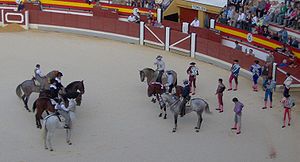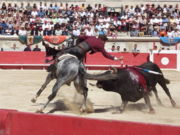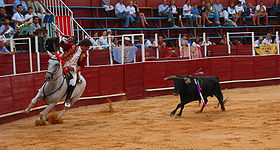
Rejoneador
Encyclopedia


Rejoneador is the name given to a bullfighter who fights the bull on horseback. The rejoneador shouldn't be confused with the picador
Picador
A picador is one of the pair of horsemen in a Spanish bullfight that jab the bull with a lance. They perform in the tercio de varas which is the first of the three stages in a Spanish bullfight.The picador has three main functions:...
, who is just an assistant of the matador. The rejoneo is an artistic form of bullfighting in Portugal and in Spanish
Spain
Spain , officially the Kingdom of Spain languages]] under the European Charter for Regional or Minority Languages. In each of these, Spain's official name is as follows:;;;;;;), is a country and member state of the European Union located in southwestern Europe on the Iberian Peninsula...
bullfighting
Bullfighting
Bullfighting is a traditional spectacle of Spain, Portugal, southern France and some Latin American countries , in which one or more bulls are baited in a bullring for sport and entertainment...
.
Classic bullfights may also exhibit a rejoneador spectacle preceding the main event but if the corrida is made up exclusively of rejoneadores, it is called a rejoneo or corrida de rejones. Corridas mixtas are also popular, where a rejoneador and two matadors (or a rejoneador, matador and novillero—an apprentice matador) perform.
The point of the bullfight is to demonstrate the skill and nerve of the rider in controlling both the bull and the horse.
A rejoneo has a scheme identical with the one of classic bullfighting. It has three stages named tercios:
- The rejoneador receives the bull after it enters the ring. He or she will try to provoke the bull to attack and run after the galloping horse (as in the suerte de capote). Then he stabs one or two of rejones de castigo ("lances of punishment") into the bull's back. This is analogous to a picador using the vara (a long lance) in a standard corrida. A rejón de castigo is a lance that has a flag on its tip that is revealed when it contacts the bull's body. As with the puyazos (jabs) of a standard corrida, the rejones de castigo weaken the bull through blood loss to allow the bullfight to evolve to a slower stage.
- Following two rejones de castigo, the rejoneador places up to six banderillas ("little flags"), harpoon-pointed colourful sticks, on the bull's back. This tercio is the parallel of the tercio de banderillas in classic bullfighting. The rejoneador may also use smaller banderillas or rosetas, which are even smaller, to show his/her ability to approach the bull. This section of the bullfight is analogous to the faena (the entire performance with the muleta - a small cape used in the last stage of the fight) of a matador. This section of the corrida is where the public will most evaluate the performance. Other displays of skill and nerve include touching the bull's head while it charges and pirouettes and other equestrian tricks.
- Finally the rejoneador kills the bull with a rejón de muerte ("lance of death"). The rejón de muerte is a sword shaped into a lance. Ideally the bull dies quickly and cleanly. On some occasions the bullfighter will need a second attempt. On others the rejoneador will kill the bull on foot by the traditional way with muleta and estoca, or perhaps more frequently will 'finish off' a slow-dying bull with the descabello (final thrust, or coup de grâce). This is a special sword designed to sever the nerves entering the head. This is also used in an analogous way by matadores facing a slow-dying bull in standard corridas.
Rejoneadores often use several horses during a performance. They are of various single and mixed breeds. Typically the rider has at least one of each of the following horses:
- A parade horse - physically attractive and disciplined
- A horse for the first tercio (entrance of bull) - very fast and brave.
- A horse for the second tercio (banderillas) - fast, agile, and a natural instinct for fooling the bull
- A horse for the third tercio (death of bull) - very steady
The horses are trained and skilled in dressage
Dressage
Dressage is a competitive equestrian sport, defined by the International Equestrian Federation as "the highest expression of horse training." Competitions are held at all levels from amateur to the World Equestrian Games...
. A rejoneador's usual costume consists of a dark waistcoat (usually brown or grey), brown leather chaps and a broad, straight-brimmed hat.
Accidents are rare. Occasionally a horse is injured or even killed. Recently (April 2007) the renowned rejoneador Pablo Hermoso de Mendoza broke his leg in a cogida in Osuna (Andalucia) that prevented him taking part in the Festival of San Isidro, which, along with Seville's Feria de Abril, is one of the art's most important fairs. The horse was not injured and he is expected to recover fully.
Cavaleiros

Portugal
Portugal , officially the Portuguese Republic is a country situated in southwestern Europe on the Iberian Peninsula. Portugal is the westernmost country of Europe, and is bordered by the Atlantic Ocean to the West and South and by Spain to the North and East. The Atlantic archipelagos of the...
bullfighting. For the Portuguese corrida de touros does not follow the scheme of the Spanish bullfighting, they only stick the bandarilhas on the bull's back. Then, they will leave the ring for the performance of forcado
Forcado
A forcado is a member of the team that performs the pega de cara or pega de caras , the final event in a typical Portuguese bullfight...
s. However, Portuguese cavaleiros are also named "rejoneadores" in Spain. When a Portuguese rejoneador performs in Spain it will take the form of the Spanish bullfight. The only discernible difference is the costume. Cavaleiros are the stars of a standard Portuguese bullfight as opposed to Spain, where in the standard corrida the matador
Matador
A torero or toureiro is a bullfighter and the main performer in bullfighting, practised in Spain, Colombia, Portugal, Mexico, France and various other countries influenced by Spanish culture. In Spanish, the word torero describes any of the performers who actively participate in the bullfight...
es are the most prominent bullfighters. (In a 'corrida mixta' (mixed bullfight) or a 'corrida de rejones' (horseback bullfight) the rejoneador whose turn it is the star). The costume of the cavaleiros is a flamboyant one, reminiscent of the clothing of 18th century aristocrats. The breed of horses they use is Lusitano
Lusitano
The Lusitano is a Portuguese horse breed, closely related to the Spanish Andalusian horse. Both are sometimes called Iberian horses, as the breeds both developed on the Iberian peninsula, and until the 1960s they were considered one breed, under the Andalusian name...
. Since bullfighting is seen mainly as an equestrian event in Portugal, cavaleiros have developed their work into an art.
Notable active rejoneadores
- Andy Cartegena
- Fermín Bohorquez
- Leanardo Hernandez
- Pablo Hermoso de Mendoza
- João Moura
- Gastón Santos, Jr.
- Diego Ventura

